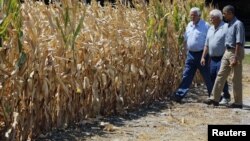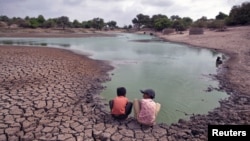GENEVA — The World Meteorological Organization warns that climate change is projected to increase the frequency, intensity, and duration of droughts. The U.N. agency said stronger national drought policies are urgently needed to lessen the devastating impacts of this recurring natural disaster.
Several regions of the world are experiencing severe drought. The United States is in the grips of one of the worst in more than a century.
World Meteorological Organization Climate Prediction and Adaptation Branch Director Mannava Sivakumar said one-quarter of the United States is experiencing exceptional drought, devastating crops and livestock.
“Currently, as of end of June, the United States has faced the longest 12-month period that it has been facing drought in the history of climatic records in the U.S. that go back to 1895," said Sivakumar.
"And, of course one of the major issues is that the forecast for the maize crop is cut by almost 27 percent ... That, of course has got a major consequence of the maize exports that the United States carries out to different parts of the world,” Sivakumar added.
The U.N. Food and Agriculture Organization reports food prices have climbed by six percent because of drought, ethanol production and high fuel costs, and are likely to go higher if drought continues.
The International Food Policy Research Institute and the United Nations are calling for the United States to end its bio-fuel program. They said this policy uses 40 percent of U.S. corn output and is creating food shortages and price hikes world wide.
India also is going through a serious drought, with rainfall in 70 percent of the country 70 percent below normal, and the United Nations predicts a profound impact on food production.
Brazil, Mexico, Australia and parts of Europe also are suffering, but data from Africa show drought this year is not as serious as in other parts of the world.
The World Meteorological Organization and other U.N. agencies are stepping up efforts to develop more coordinated and proactive policies for managing drought risk.
Mannava Sivakumar said it is urgent for countries to develop national drought policies that are legally binding. He said only one country, Australia, has a national policy.
“What is the difference between a plan and a policy? Plans and their implementation depend very much upon which political party is in power," said Sivakumar. "Some parties may take the plan very seriously and implement it to the word. Other parties may, say, just put the plan aside and give priority to some other issues that the party feels is important. But, a policy, irrespective of which party is in power, you are bound by what is written in the policy and they are legally bound to implement.”
Sivakumar said governments should first do a vulnerability and impact assessment of a drought disaster, then create a monitoring and early warning system, followed by relief measures once the drought is underway.
The measures, he said, may include government subsidies, tax relief to affected communities, and drought insurance.
Several regions of the world are experiencing severe drought. The United States is in the grips of one of the worst in more than a century.
World Meteorological Organization Climate Prediction and Adaptation Branch Director Mannava Sivakumar said one-quarter of the United States is experiencing exceptional drought, devastating crops and livestock.
“Currently, as of end of June, the United States has faced the longest 12-month period that it has been facing drought in the history of climatic records in the U.S. that go back to 1895," said Sivakumar.
"And, of course one of the major issues is that the forecast for the maize crop is cut by almost 27 percent ... That, of course has got a major consequence of the maize exports that the United States carries out to different parts of the world,” Sivakumar added.
The U.N. Food and Agriculture Organization reports food prices have climbed by six percent because of drought, ethanol production and high fuel costs, and are likely to go higher if drought continues.
The International Food Policy Research Institute and the United Nations are calling for the United States to end its bio-fuel program. They said this policy uses 40 percent of U.S. corn output and is creating food shortages and price hikes world wide.
India also is going through a serious drought, with rainfall in 70 percent of the country 70 percent below normal, and the United Nations predicts a profound impact on food production.
Brazil, Mexico, Australia and parts of Europe also are suffering, but data from Africa show drought this year is not as serious as in other parts of the world.
The World Meteorological Organization and other U.N. agencies are stepping up efforts to develop more coordinated and proactive policies for managing drought risk.
Mannava Sivakumar said it is urgent for countries to develop national drought policies that are legally binding. He said only one country, Australia, has a national policy.
“What is the difference between a plan and a policy? Plans and their implementation depend very much upon which political party is in power," said Sivakumar. "Some parties may take the plan very seriously and implement it to the word. Other parties may, say, just put the plan aside and give priority to some other issues that the party feels is important. But, a policy, irrespective of which party is in power, you are bound by what is written in the policy and they are legally bound to implement.”
Sivakumar said governments should first do a vulnerability and impact assessment of a drought disaster, then create a monitoring and early warning system, followed by relief measures once the drought is underway.
The measures, he said, may include government subsidies, tax relief to affected communities, and drought insurance.







